After rain almost throughout March, we began April with the rivers in full flood. Lake fishing was really the only option for a while. AF from Swansea with a friend caught 10 trout from the Usk Reservoir on the 2nd, mainly on a Mepps Vibrax spinner. TD from Llanbydder fished at Llyn Teifi and had 9 trout of around 12 inches using both wet and dry flies. On the 3rd CB from Caerphilly with a friend were very unhappy to fish at Llwyn On and fail to catch. This was not his first blank on the stocked water CB wanted us to know, and it therefore follows somebody must be to blame: “Ridiculous. Lake is woefully short of fish, yet you have the audacity to increase the price.” The Foundation pointed out that it is the owner, not the Passport Office, who sets the price. Meanwhile IS from Beddau, who was also at Llwyn On the same day, in his case fishing alone, recorded an extraordinary catch of 30 trout. I presume he bought 5 tickets? GD from Merthyr Tydfil reported an even larger catch of 40 trout on the following day. 1 x 4 fish ticket and 6 x 6 fish tickets? Or was it catch and release after the limit was taken? The mind boggles. That comes to 70 fish for two angler/days at Llwyn On. I guess we know where all the trout went.
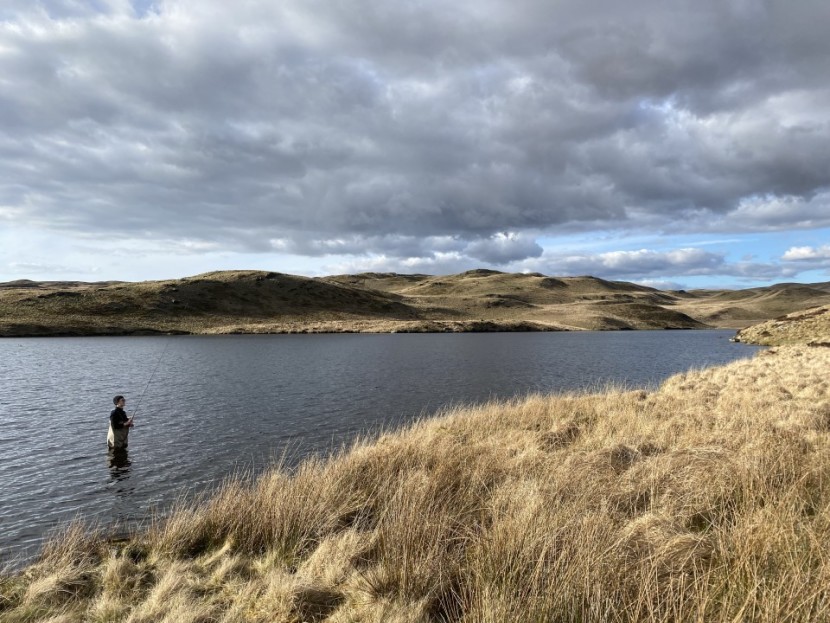 Llyn Egnant - CP from London
Llyn Egnant - CP from London 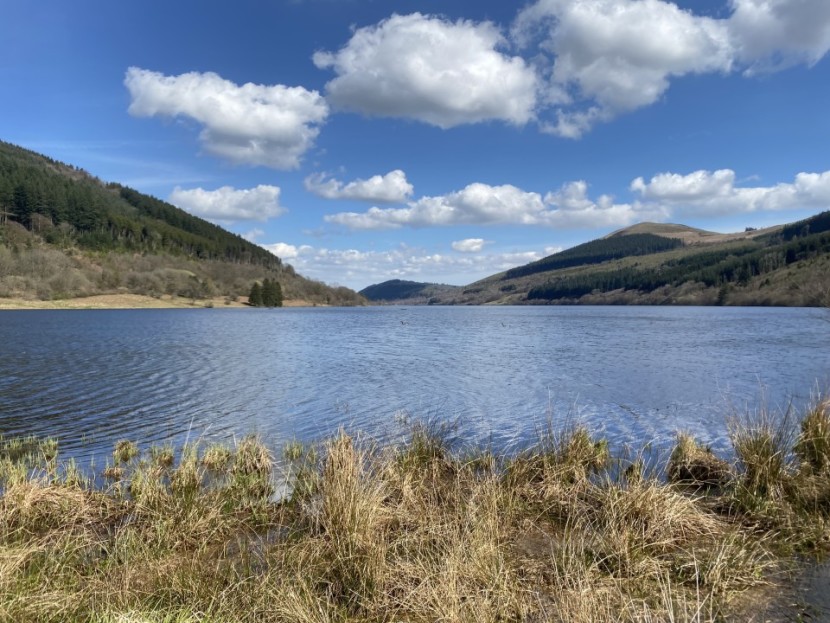 Sunshine at Talybont - SR from Maesteg
Sunshine at Talybont - SR from Maesteg By the 4th the upper part of the Usk, which had always been running clear if high, was entering into fishing condition provided wading was careful. The Wye was still high and quite muddy, particularly below the Lugg junction. However, HC from Exeter managed to catch 5 trout from Craig Llyn on the upper river.
AW from Ledbury found himself unable to fish the Lugg at Eyton on the 5th and queried why more guidance isn’t given about water levels. This is more difficult than it may seem. In this case the WUF gauge for the Lugg had been out of order for months, while the EA gauge at Byton levels was showing around 0.75 metres. To me that’s a flood and the history provided by the EA gauge on-line system should have indicated that the water was abnormally high. Realistically I would not recommend trying the Lugg unless the level is something like 0.50 metres or below, but that is hardly an absolute rule. This matter is quite subjective and a couple of inches makes a lot of difference in a small river like this. The Lugg has a characteristic that it takes a long time to rise during spells of heavy rain, but once up, it stays up for a long time.
At any given height, some beats will be easier to wade than others and this is true of any river. For what we all want to find, which is a taking fish, much depends on the colour and indeed whether the level is on the way up or on the way down. For trout and grayling (but not necessarily salmon) I would prefer to fish a falling river than a rising river. And of course different anglers have different tolerance levels about fast water wading and different ways of fishing in fast water.
At times the Passport Office has the somewhat difficult job of determining what constitutes a wash-off on the day, but I imagine a description something like “can’t be fished; too dangerous to get into” would cover most of our wash-off situations. In practice it’s quite difficult to provide a yes/no reading for water levels on every beat as AW is asking and I think anglers would be best advised to take time to study their favourite rivers and how they fish at different levels. Most of my own theories about the Wye and Usk river levels and how they affect fly-fishing are recorded in the September 2015 newsletter, archived on the WUF site. My suggestion to you is to keep a fishing diary and along with your catch results record the levels along with the weather. It will pay off over time.
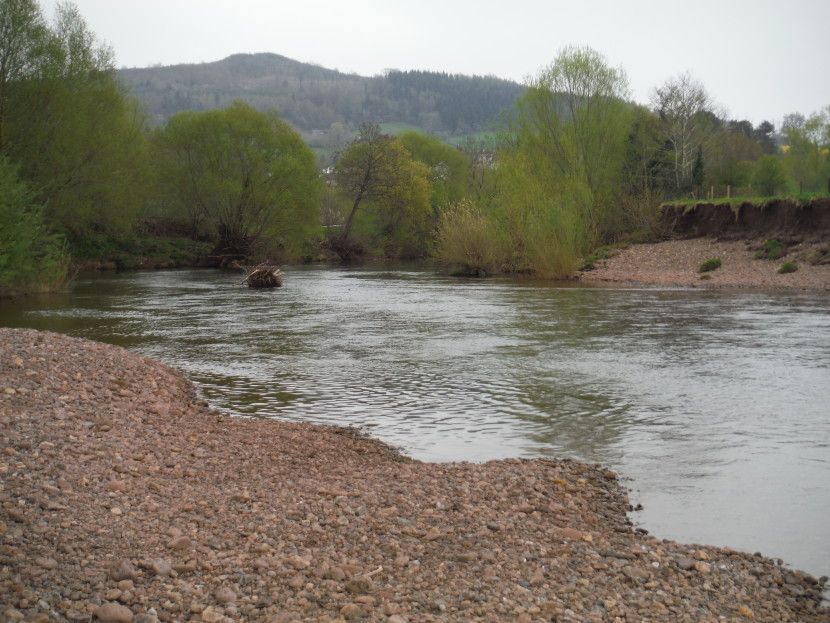 Abergavenny Town Water in spring
Abergavenny Town Water in spring 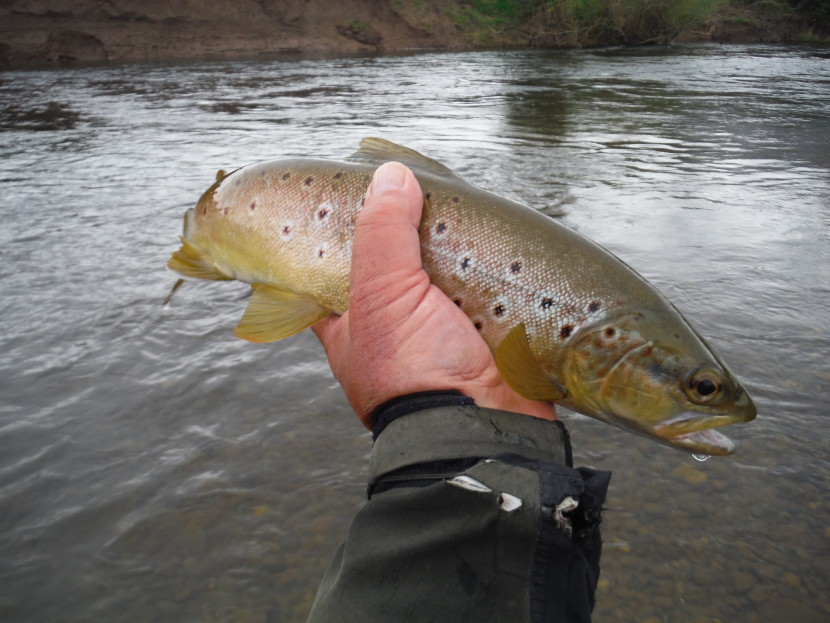 Abergavenny trout
Abergavenny trout On the 4th Rod Lloyd had a hen of 14 pounds fishing at The Rocks above Builth Wells. I think this must be the highest up the river so far. On the 5th the Spreadeagle beat reported a cock salmon of 21 pounds, 5 ounces. See the photograph of a classic Wye springer. It came from Adams Catch, a little above the Llynfi junction. One of the regulars said to me the other day: “I know salmon numbers are down. But the Wye is still a river which can give you a really wonderful fish, a once in a lifetime fish.” I can’t add anything to that thought. As the level dropped, we began to receive more confirmation that salmon had reached the middle and upper Wye. Golden Mile reported a 20 pounder taken with a Devon Minnow on the 7th while Ballingham had another. Nathan Jubb had a 15 pounder spinning at Whitney Court and there was talk of two more fish being lost on the upper river.
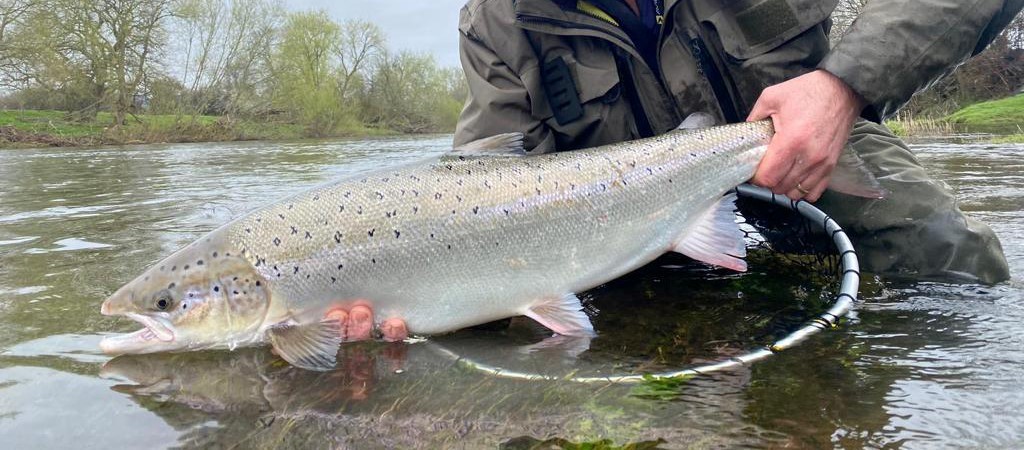 21 pounds 5oz fresh cock salmon from Spreadeagle
21 pounds 5oz fresh cock salmon from Spreadeagle On to the Easter results and the holiday began with clear skies leading to frosty mornings and hot afternoons. I would prefer to avoid big temperature swings during spring fishing but of course we must take what conditions we find. The hatches were not wonderful, and at times the trout seemed not to react to the presence of fly at all.
The exception was that the large dark olives and March browns were joined by some early and quite intense grannom hatches on the middle Usk. At Dinas on Good Friday, JN from Birmingham with a friend had to wait until 3 o’clock for a short hatch of March browns with a few olives also present. This late burst of insect activity got them 5 trout including 2 on a Red Spinner. MR from Narbeth reported 7 trout from Ashford House – see the photograph below.
EA from Worcester blanked on the Teme at Bucknell, but I think it was a good idea to try. You are never sure what might have arrived in those deep pools during the floods of winter. GH from Norfolk fished at Llwyn On and apart from a single rainbow caught a rather fine brown trout of 4.1 pounds, which he returned. Meanwhile DS from Wigan with a friend caught 10 trout from Llyn Ogwen, but NB from Presteigne with a companion were unable to catch at all from Llyn Bugeilyn. Clear and bright conditions and a lack of wind would not have helped, but this failure is somewhat unusual and my guess is that it was just too early in the season for this very high lake to produce. There was, however, a very good view of Cader Idris and the Snowdon range to the north. I am more used to cloudy, rainy days up there and at sunset on a wet day you get to see the sort of red fiery landscapes that Turner liked to paint.
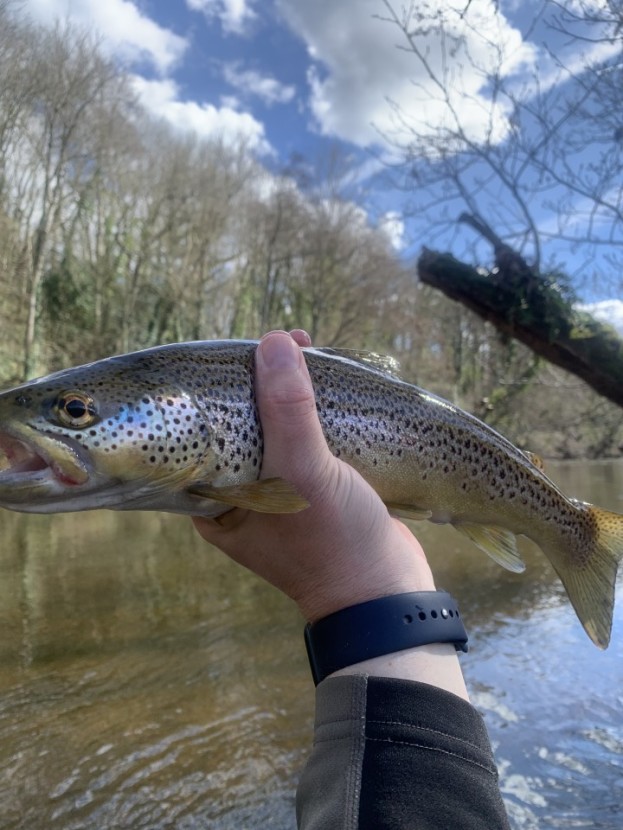 Ashford House trout - MR from Narbeth
Ashford House trout - MR from Narbeth 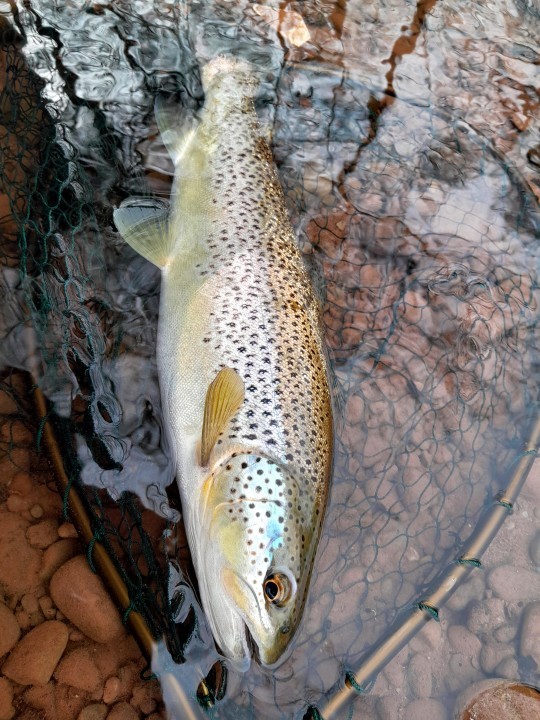 Usk March brown feeder - Seth Johnson-Marshall
Usk March brown feeder - Seth Johnson-Marshall On the Usk, D from Surrey reported trout of 18 and 19 inches from Cwmwysg Ganol. Assuming normal condition, those measurements would equate to a brace weighing 2.5 and 3 pounds, quite a catch even for this river. Seth Johnson-Marshall, my patient editor, used dry flies to catch 4 specimen trout of about 2 pounds each from the upper middle Usk during a March brown hatch. That would have constituted a memorable afternoon. AB from Burton on Trent, who makes videos I believe, had half a dozen fish in water which was still high at Glan y Cafn downstream. He fished the Abergavenny Town Water on Easter Sunday and caught 7 trout in a good hatch “until the weather turned.” JL from London with a friend caught 12 fish to 18 inches from Dinas on dries and nymphs. We heard some more from anglers who had blanked on the Welsh Water Co reservoirs during the holiday and were consequently very unhappy. PE from Ledbury did not have a good day on the Usk Reservoir and concluded in a report full of capital letters that it is being raided by foreigners at night. His main evidence for this is the number of burned out camp fires along the shore. I’m sure the landlords will have taken notice of his report and concerns about the fires. Meanwhile, I note that DD from Neath had 3 trout from the Usk reservoir on the same day (Easter Sunday) and KG from Llangadog had 4 on the Monday, so it seems a few fish are being caught. There again, RH from Cardiff with a friend reported an “absolutely terrible day” having failed to catch at Llwyn On.
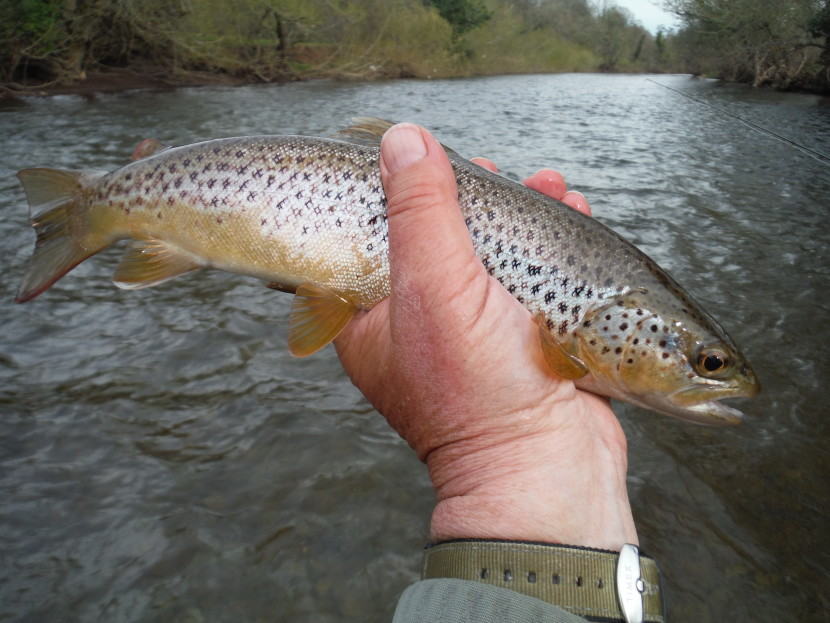 Abercynrig trout
Abercynrig trout 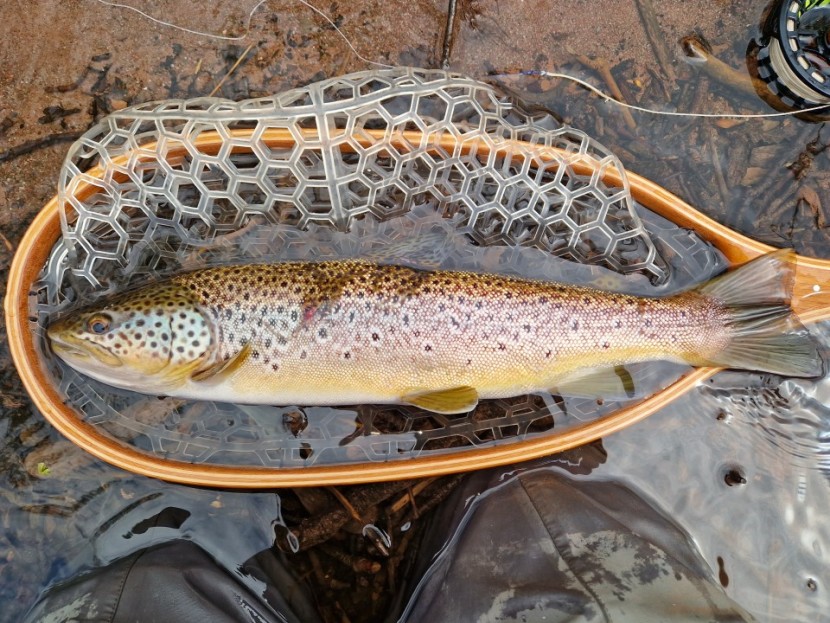 Upper Tower trout - BG from Exeter
Upper Tower trout - BG from Exeter 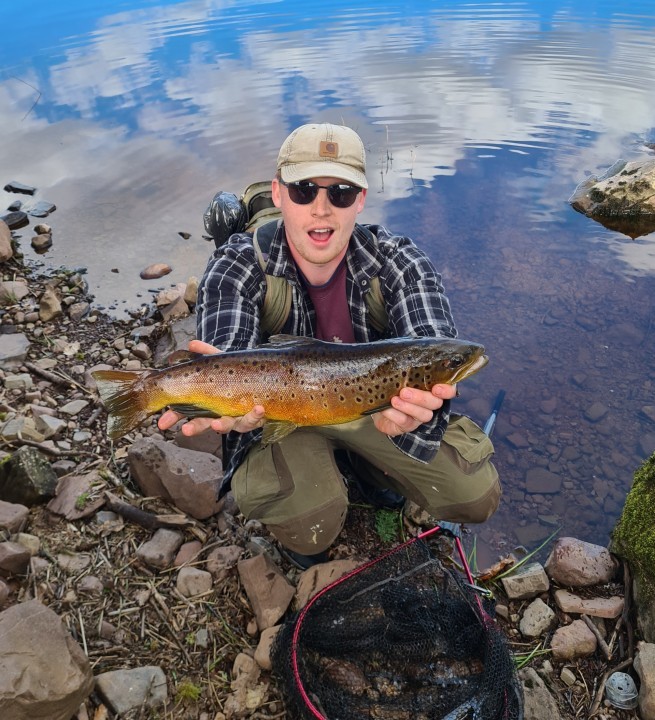 Llywn On brown trout 4.1 pounds - GH from Norfolk
Llywn On brown trout 4.1 pounds - GH from Norfolk Personally I could subscribe to describing Easter Monday as an “absolutely terrible day,” at least in terms of the weather. Great black clouds pushed inland on a cold gale which always somehow seemed to be blowing downstream. Our hats blew off and we were showered with stinging rain and sleet. It was difficult to be managing a fly line, let alone to find hatching insects or catch a fish. However, I had the pleasure of watching Tom Armstrong of Truro catch his first trout, a 15 inch cock fish from Dinas which took a Deer Hair Emerger during a very brief emergence of March browns. There were a couple more on spiders for him later, one of which I netted from water peppered with falling hail.
DS from Dymock described “horrible weather” at Cefn Rhosan Fawr but was delighted with a single trout of 19 inches, or 2 pounds 12 ounces, during an olive hatch. And TD from London found the carp in a lively mood at Trelough Pool. He caught 5 of them between 9 and 16 pounds. For all the bad weather, this was the week the martins arrived, ready to rear another generation in holes in the Usk’s sandy banks. I love to fish when the martins are around, because they can be relied upon to be the first to give warning when a hatch begins.
Salmon fishing over Easter concentrated on the middle and upper Wye, although water levels were still quite high. The Golden Mile reported a 20 pounds fish on Devon Minnow on Good Friday, and another of 17.5 pounds with the fly on the Saturday. Ballingham also had a fish and Richard Thomas had an 18 pounds cock fish at The Rocks. Glyn Cawte had a 17 pounds fish on a Flying C at Lower Carrots and Luggsmouth on the Saturday. On Easter Monday Ralph Hanraads had a fish spinning at Whitney Court. Nathan Jubb had another of 20 pounds from the same beat a day later.
Following Easter we pressed on still in pretty cold and unpleasant weather, high winds and heavy showers. MH from Swansea with a friend fished the Breconshire water to catch 11 trout to 14 inches, using emergers and such wet flies as Usk Naylors.
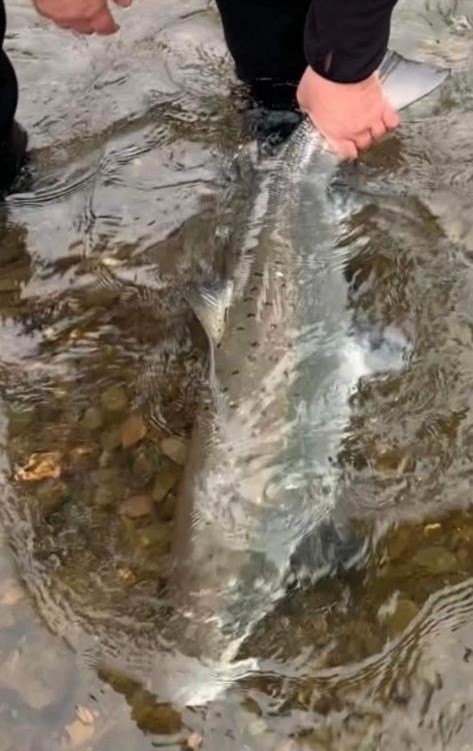 Whitney Court springer - Nathan Jubb
Whitney Court springer - Nathan Jubb Traditional Welsh wet flies like the Naylor come into their own in high water spring fishing on the Usk. The Brecon Cob, which is meant to be a March brown imitation, is another one I like, usually in size 12. Put it on the point of the team and fish it round as slowly as possible.
On the subject of March browns, many anglers complain that it isn’t always easy to match this hatch and certain patterns will score on certain days, but not on others. I think that there are specific times when trout want the rising nymphs, or the emerging fly, or perhaps again the completed dun siting high and dry on the surface ready to fly away. I do remember a difficult day when a sort of loop wing emerger by Paul Proctor fished awash was apparently the only artificial they would take, but it took a while to find this out. While you are trying to work out the secret of puzzles like these, the minutes are ticking away and hatches do not last for ever.
One emerger pattern which in my experience scores pretty consistently during a March brown hatch is no more or less than the good old DHE of Bob Wyatt. If in doubt, start with this one. The whole point of the Deer Hair Emerger is that you are showing off the wing, like a 45 degree tick mark on the surface, so that it is as prominent as possible. In the case of March browns, I make the DHE on a fine wire hook of size 12 or maybe 10. The wing should be good dark roe deer and rather longer than usual. Roe deer is not the most buoyant of deer hairs (I generally use American coastal deer for other imitations), but it is certainly the right colour. The body should be of dark hare’s ear and ribbed with the same rusty orange silk used as tying thread. This may not look very neat, but it shows up well even in rough water, both to the angler above and the fish below.
It rained so hard on the 12th that both our rivers rose again in flood, putting an end to fishing for a while. The exception was a report from JL from London who with a friend fished the Usk at Penpont and caught 7 trout on weighted nymphs in slack water. By the 15th PD from London was able to take 5 trout from Dinas with nymphs, while TS from Bristol reported 19 very small trout from the Usk Reservoir. On the 16th JC from Bristol was up at Llyn Teifi and described fishing a team of traditional wets such as Teal Blue and Silver with a long leader. “Westerly wind and a bit of a chop,” he wrote. Those conditions sound right and a slow retrieve got him a leash of hill trout.
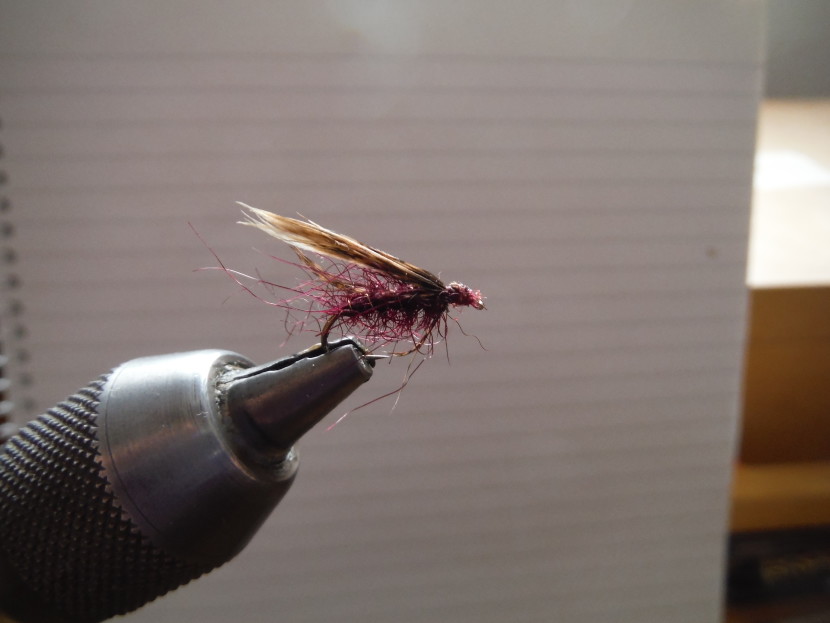 Brecon Cob
Brecon Cob 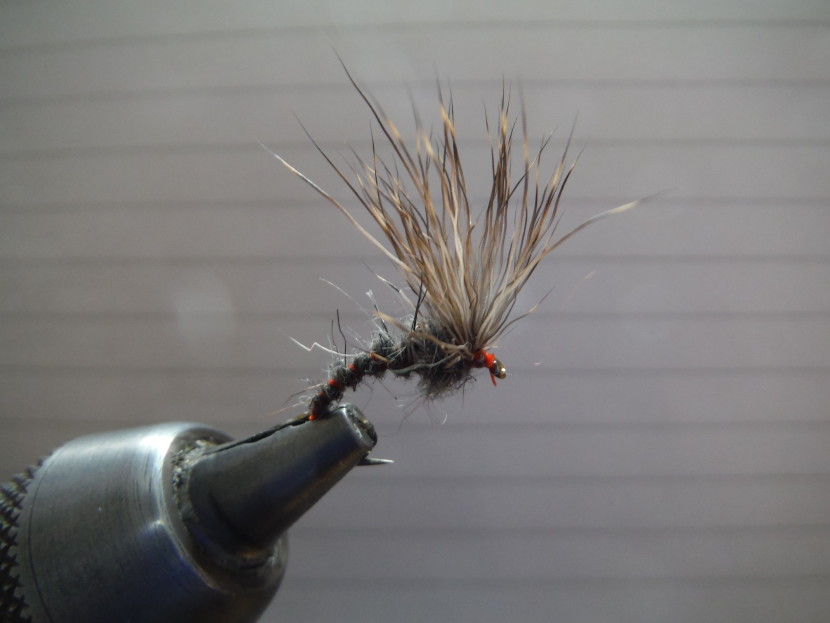 Roe Deer Hair Emerger
Roe Deer Hair Emerger 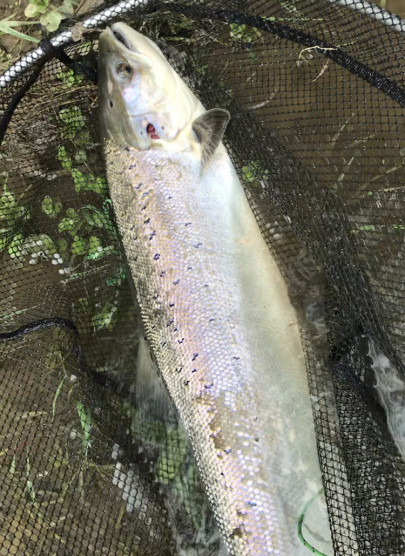 36 inch springer for MH of Swansea at the Rectory. Note the injury on the gill cover.
36 inch springer for MH of Swansea at the Rectory. Note the injury on the gill cover. Persistence paid off for MH from Swansea who is a salmon fishing member at the Rectory. The Llanstephan gauge showed 2ft 5inches on the 16th which would suggest a height more suitable for spinning, if you enjoy to spin. However, despite an initial lack of confidence, MH started off with the fly rod, sinking tip and a small Pearly Tosh Tube and after 20 minutes got himself a 36 inch springer, which looked perfect except for an old injury to a gill cover.
Moving to the other end of the size range, SG from Fareham got himself 12 trout from 4-10 inch on nymphs from the Forest of Dean’s Blackpool Brook, which was also an achievement. GC from Pontypridd had 8 trout on spiders from the Usk at Abercynrig. The river was still high and the Cynrig brook was running in quite dirty after overnight showers. JA from Rhayader reported just two trout from the Edw brook at Hergest. It’s worth noting that although there is plenty of water in the upper tributaries, it has been a cold spring so far and the brooks usually take some time to warm up, starting with those at lower altitude – hence perhaps SG’s experience in the Forest of Dean at Blackpool Brook. NS from Worcester was due to fish Cefn Rhosan Fawr on the 16th, but reported with a laconicism which close mouthed US President Cal Coolidge would have envied: “Didn’t go. Wife issues.”
The Rectory produced another springer on the 17th, this time a fresh cock fish for LD from Hereford. He caught it on the fly from under the power lines right down the Bridge Pool. It wasn’t such a good day for MH of Swansea who was now fishing at Llangoed and Upper Llanstephan where he broke the tip section of his rod. Thankfully Airflo at Brecon produced a replacement on his way home. AF from Churt, near Farnham in Hampshire, fished at Dinas and got 6 on nymphs and spiders. There was a March brown hatch during the early afternoon. Meanwhile IS from Beddau could manage only one from the stocked Llwyn On reservoir: “One fish all day can’t have put many fish in Thursday waste of money.” IS, it will be remembered, was the angler who reported catching 30 trout from the same reservoir on 3rd April. From feast to famine; it seems that results have evened out for IS. AL from Treorchy with a friend recorded catching a moderate 8 trout from the same water on the same day. Gillie Stan Turner caught a fresh 2 sea winter fish on spinner at the middle Wye’s Aramstone. JC from Penarth had this to report about a day at Dinas: “Around 12.30 the sand martins went mad as a hatch of olives and March browns began. Trout quickly got turned on and I had a mad 45 minutes where every cast was to a rising fish. Four nice WBT to the net and lost several others. Hatch stopped as quickly as it started – but great fun while it lasted. Classic Usk fishing.” CE from Worcester had three trout from Upper Tower, but found himself sharing the beat with an otter.
On the 19th Mark Harris of Swansea had a fresh hen fish from the Chapel Gutter pool of Llangoed and Lower Llanstephan. This is an unusual place, virtually without gravel. You make your way down a long flat platform of rock, fishing across or if possible down into a deep gutter which takes most of the river’s flow. He fished all day, dawn to dusk, to get it. Brian Skinner had a fresh three sea winter fish from the Rectory on the following day. This one measured 39.5 inches and came from the Mill Pool, a curiously offset pool among the rocks half way down the beat. DF from Shropshire caught a 15 pounds springer from Spreadeagle during a Sportfish tackle demonstration. NS from Worcester was very unhappy with his day on Glan y Cafn just above Abergavenny on the 20th. The access, he felt, was too difficult and dangerous. Glan y Cafn produces some good trout on occasions, but I admit it is a long time since I fished it, mainly because the price always seemed high. Currently a day’s trout fishing is 40.50 including the booking charge. As I recall, the steps and the long concrete walkway along the bank were in a particularly bad state of repair when I was last there. An option would be to skip the concrete section and wade what is left; however the water would have been too high for wading during NS’s day on the beat. In summary, I think NS may have a point. At 40.50 a pop for trout fishing there should be sufficient margin for access improvement and maintenance.
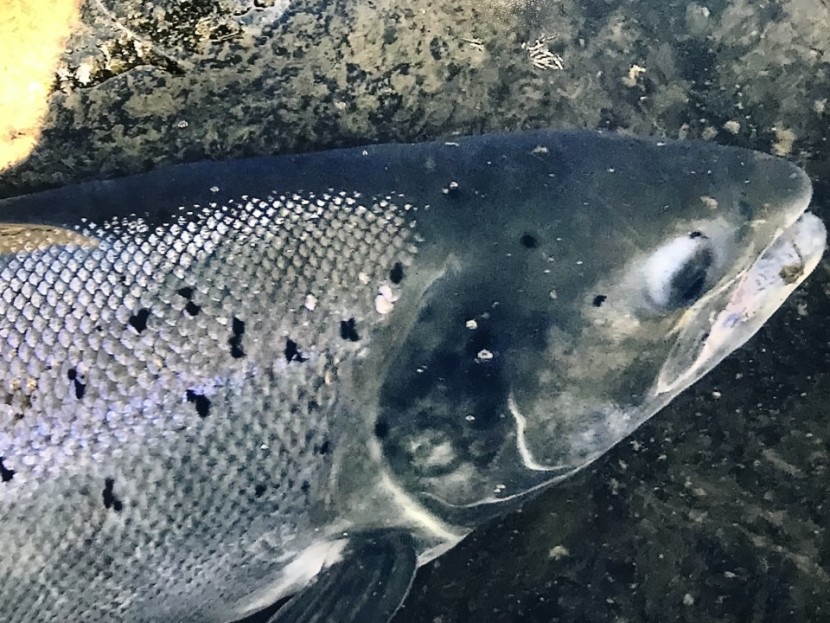 Llangoed and Lower Llanstephan - Mark Harris
Llangoed and Lower Llanstephan - Mark Harris 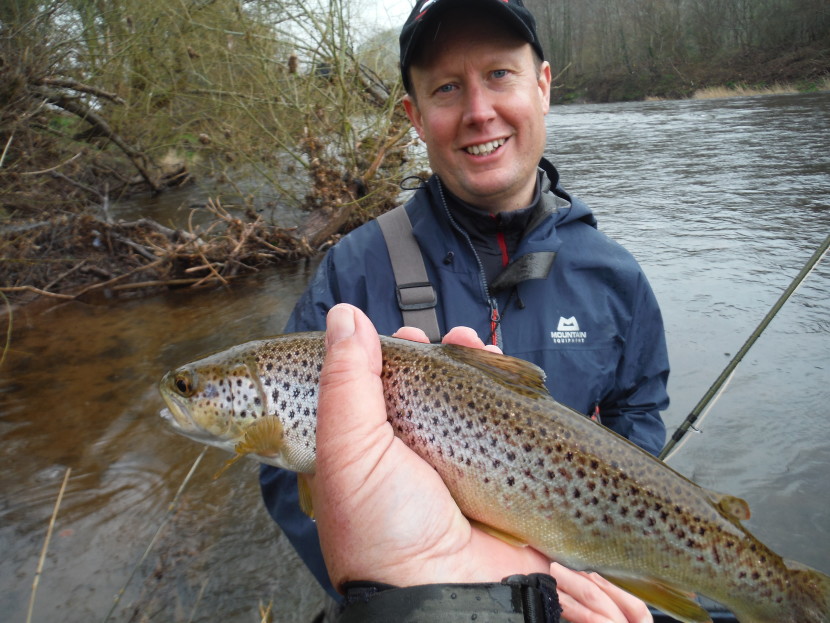 Brecon high water
Brecon high water On the 21st regular salmon angler Ricky Reno had a fresh fish of 20 pounds on spinner from Garnons on the middle Wye near Moccas. Meanwhile RB from Caldicot had 8 small trout from the Beacons Reservoir on a Claret Dabbler. DH from Bath reported 3 kayaks trespassing on the Usk at Penpont. SM from Neath had 5 trout on nymphs from the MTAA water of the Taff on the following day. TH from WR11 8LG who fished the Teme at Bucknell with a friend on the 22nd had this to report: “Only observation. A 4x4 silver Nissan came down the opposite side 2 men fished a few runs using a spinner. Thought this was odd we didn’t approach them but thought you might need to know.” TH, I have to tell you that there was nothing odd at all about this event. It’s about as clear as can be. The Bucknell beat is double bank, fly fishing only, with two tickets which you had, so it follows that these men were poachers. What did you say to them? Did you call the police? What was the number of their vehicle?
On a more cheerful note, the Ross Angling Club had another salmon on the 24th. This was a 22 pound cock fish covered in sea lice caught at Weirend by Jon Daniels on a Flying C. All parts of the Wye were now coming into condition. Wyesham reported a fish of 18.5 pounds on spinner. Stan Turner, gillie at Aramstone, reported a giant of 44 inches, also on spinner. Tom Hannon kicked off the Usk fishing with a salmon of 16 pounds at Chainbridge on a Silver Doctor. Wyesham had another springer of 12 pounds. Salmon fishing was becoming almost busy!
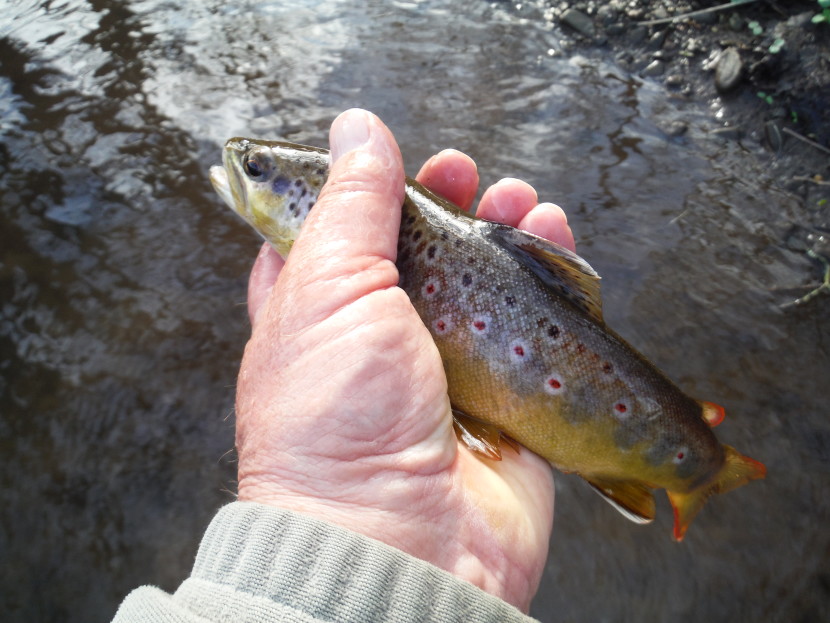 First Forest trout of the year
First Forest trout of the year 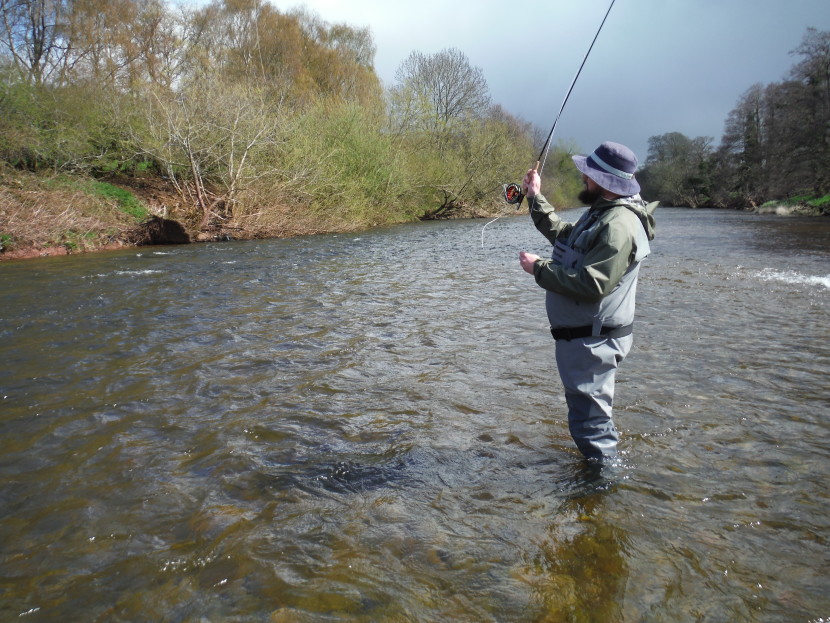 Fishing in a gale at Dinas
Fishing in a gale at Dinas MH from Swansea reported a very sparse hatch of olives on the Breconshire Fishery on 25th April, but the trout weren’t playing at the surface suitably for a dry fly approach. Instead he used spiders and got 8 fish, although many takes were missed. NP from Cullompton reported a 2 pound brown trout from Ashford House, while RB from Redditch had 7 trout at Dinas. The Golden Mile reported a 12 pounds salmon on a Black and Red Flying C, while John Power from Yate with a friend had a salmon on a Blue and Silver spinner opposite the Boat Inn on Whitney Court. BG from Exeter had a trout of 18.5 inches in a brace taken at Upper Tower. He thought the recent injuries on the back and flanks of the larger fish to be the result of an attack by an otter rather than a cormorant. I am not quite so sure; amazing as it seems a cormorant is capable of swallowing a 2 pounds trout and I wouldn’t put it completely past one to attack a trout of 2.5 pounds. BG also found evidence of dormice feeding on hazel nuts in the area. Not many people have seen a dormouse in recent years; it would be nice to think that we have them in the Usk valley. On the 28th, as the bank holiday began, CH from Bromsgrove caught a predator-damaged trout during a March brown hatch at Ashford House. Again, the photograph made me suspect a cormorant and I am afraid this sort of sight is all too common. PH from Beaumaris reminded anglers fishing at Titley on the Arrow to park right under the yew tree and make sure access is not blocked to the cottage. And James Tustin had a 16 pounds cock salmon from the Rectory beat of the Wye. We hear about fish being lost there, so there must be a reasonable number in.
The weather during these last few days of April had been miserably cold with drenching showers of rain and in many cases a lack of hatching flies which might have made life easier for trout anglers. David Burren and I took a trip down to the Wiltshire Avon at Heale, with the idea of seeing what we could do, even though the fishing date was still early by chalk stream standards. The fact that we start our Welsh trout fishing on 3rd March is a source of perpetual wonder for the anglers of chalk stream counties, who find the first days of May early enough to get going. I made the point about fishing which is that you can never really tell how a day is going to turn out. You have to keep trying in a spirit of optimism and see what turns up. We were even ready to use dry flies! We arrived to find the main Avon right up level with the meadows, all the hatches open and the river running at a tremendous pace with some colour in it. The carriers, on the other hand, had been left at the usual hatch settings and so had their normal flow. The first thing I did was run a small and speculative Parachute Adams down the run immediately below the carrier hatch by the Turbine and was rewarded at once with a 10 inch wild brown trout. Nothing unusual about that, but it was a confidence builder.
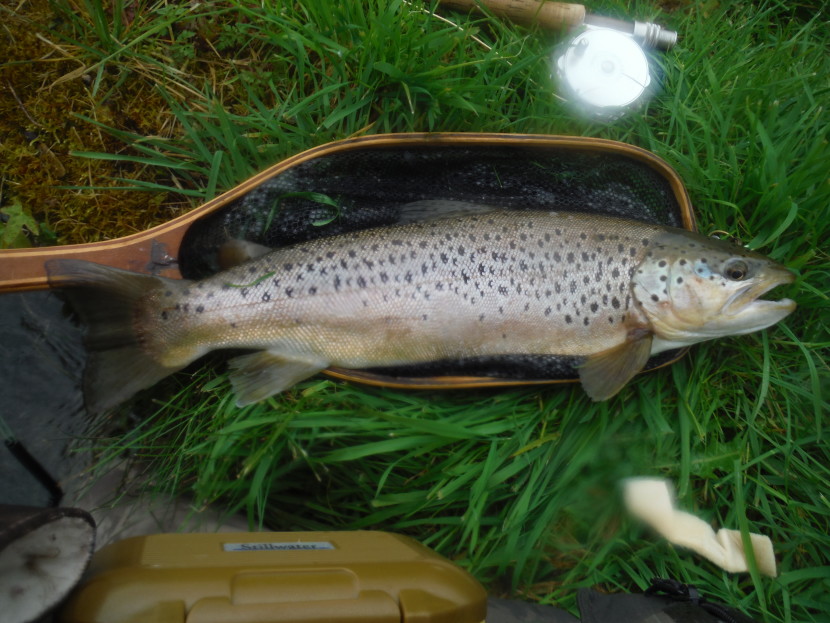 Avon trout
Avon trout 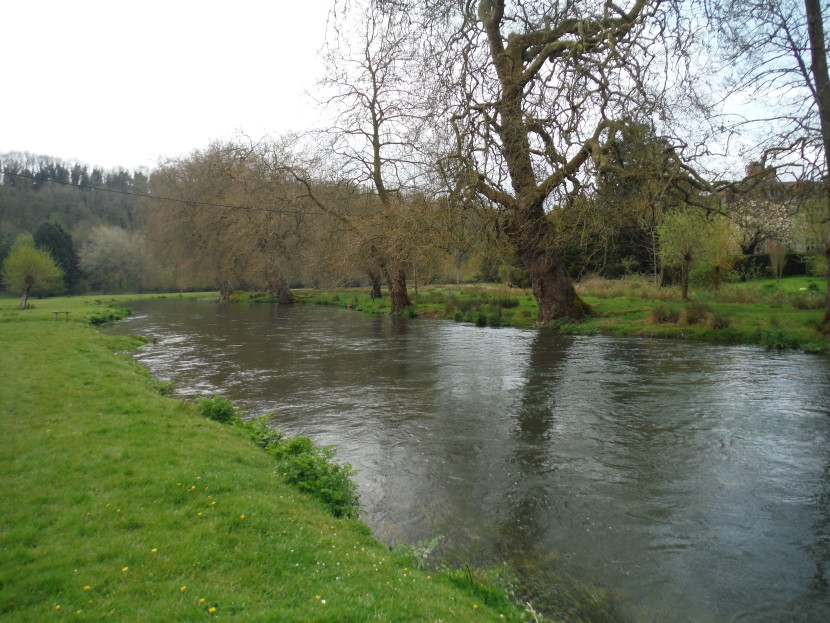 Heale under the plane trees
Heale under the plane trees Then we split up, David to search the calmer and deeper water above the Turbine hatches, while I went down to the main river under the plane trees in front of the House. The current here was still quite strong, but there was a very occasional rise in the margins here and there. Every one of these turned out to be a tiny wild trout or an out of season grayling. These little things became quite annoying and it was beginning to rain heavily in a most depressing way, but then I saw the swirl of a heavy fish rising in the middle of the deep channel under tree branches. I tried it unsuccessfully with the dry fly several times, but then put on a size 12 Tungsten Hare’s Ear nymph, walked it downstream under the branches until the leader tensed and got into a bruiser of a trout which constantly hugged the bottom during play. There were no fireworks at the surface, but it was rather like being attached to a stately salmon which had its nose down on the bottom. It was one of keeper Peter Major’s “Jurassic” stock fish from last year and very fit after over wintering in strong currents. The 21 inch trout didn’t want to go into the net, so I ended up leading it into a flooded side ditch and sort of cornering it to remove the hook before sending it on its way.
After lunch and with the rain continuing I went above the Turbine to explore the river all the way up to the road bridge in Woodford Village. A very few flies were around, including medium olives, a few pale wateries and I think I saw iron blues braving the rain for a moment, but there was no real pattern to the hatch and the only fish that rose were again small trout and grayling. Then, having worked back downstream all the way to the Turbine I suddenly saw the shape of a very large trout rising from the depths and then hunting downstream after my size 16 Parachute Adams. It wanted the fly alright and an even more dogged struggle ensued with the fish aided by a strong current dominating the situation for quite a time. I was very much aware that I had an open hatch below me and an open hatch above me; if the fish should lose strength or get sucked into either intake and down the race to the pool 6 feet below that would be the end of the affair. There was a long period with the 4 weight rod hooped over and applying side strain before I got the fish first to the surface and then eventually towards me. I persuaded it uncomfortably doubled up into the net at about the third attempt. This was an even larger fish, heavy in the shoulders, of 23 inches. This one went back too, but even by the standards of chalk stream fishing for stocked trout the pair made the best brace of brownies I can recall catching in a day. Peter Major turned up then for a chat before feeding his stew ponds and going to attend to his deer stalkers who were scattered on the higher slopes and woods of the valley ready for evening shooting. David had also had a couple of good fish and, soaked as we were, we agreed it had been a good day before heading home.
At the beginning of a casting lesson, more often than you might imagine I will be working with a client who has never before held a fly rod, and maybe not even a fishing rod of any kind. That is not a problem in itself as at least no basic mistakes or bad habits will have been ingrained. We can start with a clock face diagram over which the mechanical principles of a cast can be explained in an encouraging way – after all it’s nothing magic, only physics including inertia, reaction and so forth. And I will usually go on to demonstrate a basic overhead cast as the next step, either on grass or standing in the shallows, with the procedure broken down into separate components and explaining the movements I make with the practice rod and explaining why the line behaves as it does. (I will write something about the different casts available and their value to both novices and experienced anglers at a later date. For now let’s just consider the novice tackling the overhead or back cast for the first time). I know that some of my clients will understand quickly and almost instinctively pick up the actions required in a short space of time. Some will require to practise it for longer before competence is achieved. Youth tends to be a great advantage. But at that interesting moment when I hand the rod over and the pupil makes his or her first attempt, it often seems a good idea and in any case kinder, to manage expectations a little. I usually try to make an encouraging speech something on the lines of:
“This will take a little time, but don’t worry too much. The thing to bear in mind is that nobody gets it right first time. Most people, including those used to hitting a ball with a racquet or a club, will find the movement required for fly casting does not come naturally. Instead of the long strokes required in most sports, in fly casting we are mostly going to use short movements to load the rod and which “accelerate to a stop.” So it’s going to be like when you learned to drive a manual car for the first time. You had it all explained to you before you started: depress the clutch, engage first gear, lower the handbrake lever, feed in a little power from the accelerator, start to raise the clutch, a little more power as the car starts to roll forward, allowances for any slope, bring the clutch right up and you’re away, at least until you need to go for second gear. All that was explained to you, but when you tried it for the first time you stalled the engine and came to a stop, didn’t you? And quite a few times after that, probably. But look, now you just jump into the car in the morning and drive to the office, probably without giving a single active thought to the gearbox, the clutch, the accelerator and how they relate to each other and the driving process. Something in the back of your brain is doing all that unconsciously, while you concentrate on the traffic and thinking about your first morning meeting. Casting a fly rod, despite what seems now to be complicated talk about line speed and loops, will eventually become just the same; when you have done enough of it there will be a muscle memory developed so that you will be able to cast accurately by feel, even with your eyes closed or in the dark, or if your mind is on other matters. It will take some time, but muscle memory will come and there are even some exercises which will help.”
Muscle memory for different kinds of repetitive actions is developed by practice and it isn’t forgotten. Like swimming or riding a bicycle, when you get it you always have it. Only if the muscles and nerves are seriously damaged will it be lost and even then it can often be relearned, just as spinally injured patients are sometimes able to relearn to walk. Exercises can be a short cut and here is a good example which once helped me. A few years back, when shooting heads came in for double handed salmon rods it was necessary to make radical changes in our Spey-casting style. With the old salmon lines with their long heads, the lower hand on the rod handle acted as the fulcrum while the upper hand did most of the work of pushing the rod forward in a long delivery stroke. With the new and shorter shooting heads, the upper hand on the handle acted as the fulcrum and directional guide while the lower hand produced the shorter power stroke by a sharp pull into the caster’s stomach. Spey rods now also had shorter handles and a stiffer action, particularly in the tip, but that is beside the point. The whole casting style had altered. Even today, novices in Spey casting still tend to use too much top hand, simply because it seems more natural.
When the shooting head revolution arrived, I could see the inherent advantage of the new system, but after years of casting the traditional way I had a problem. I just couldn’t seem to stop using that upper hand for most of the casting stroke. Eventually, I consulted a colleague (Mark Roberts) who suggested that through the winter off-season I spend a few minutes every day sitting in a chair facing a mirror holding the butt section only, but making that lower hand movement only until it became instinctive. It seemed to work. A broom handle or a garden cane would work just as well, provided you can check you are making the right movement.
Another example concerns me right now, in that I’m trying to change the way I handle a sporting gun before taking a shot. Natural game shots usually take a moment to mount the gun with the butt of the stock in the shoulder and the comb tucked into that important gap between the cheek bone and the lower jaw before shooting. In any case they could hardly stand around waiting for pheasants with a heavy shot gun already mounted. So they wait dismounted “gun down” and after practice it only takes them a split second to move the gun into the “gun up” mounted position in the shoulder before firing. This is why shooters pay so much attention to what they wear on the upper body and the reason for those leather patches on shooting vests so that the gun moves easily and smoothly into position.
It is rather different in the case of the various clay target sports, where the shooter calls for the imitation “bird” himself. In Olympic-style trap shooting, the targets are all quite similar, going up and away at slightly different angles. In this case most shooters wait mounted “gun up,” muzzles waiting just above the trap house and looking down the rib, knowing that very little movement will be needed to get on the target. Specialist trap guns incidentally usually have an intermediate sight as well as a fore sight on the rib, a high comb and in fact tend to shoot a little high with the majority of the pattern of shot above the centre line. All of this helps for the trap discipline and rising targets. In the locally more common Sporting Clays variant of the sport, which is intended to mimic real game shooting with a great variety of shots and angles, the majority of shooters I know call for the target and also wait for it with the muzzles towards the chosen “kill” position and mounted “gun-up.” The idea, which seems logical at first, is that the shooter will thus be enabled to get more quickly onto the target and to break it.
There is another view, however. Some of the best sporting shots I watch almost always wait for their bird gun down, the heel of the stock just below the shoulder, and then as the bird comes into sight lean forward slightly while moving the comb into the cheek just before firing. It’s always the same movement and lovely to watch. Guns for sporting are normally built with just the one fore sight above the muzzles. The important point is that the back sight is in fact the shooter’s eye. The idea here is that the shooter looks out for the approaching bird and gets his eye locked on, but then, without moving his head, moves the gun forward and into the ”up” position with the comb tucked into the gap between his cheek and jaw, while the butt is safely in the shoulder pocket. If the mount is done correctly, his eye (or both eyes if he can manage to shoot with two eyes open) will now see the foresight against or just below the target and the rib will almost have disappeared. If lead is required, he will obviously have to calculate for that. And again, those who like to shoot gun down argue that the process is quicker. Having taken the first shot at the first bird, the shooter normally has time to drop the gun out of his cheek and then remount it in time for the second target and the second shot. (Incidentally FITASC is a sporting clays variant in which, when calling the bird, the heel of the stock must be held just below a line marked on the shooter’s vest, so necessarily “gun down.”)
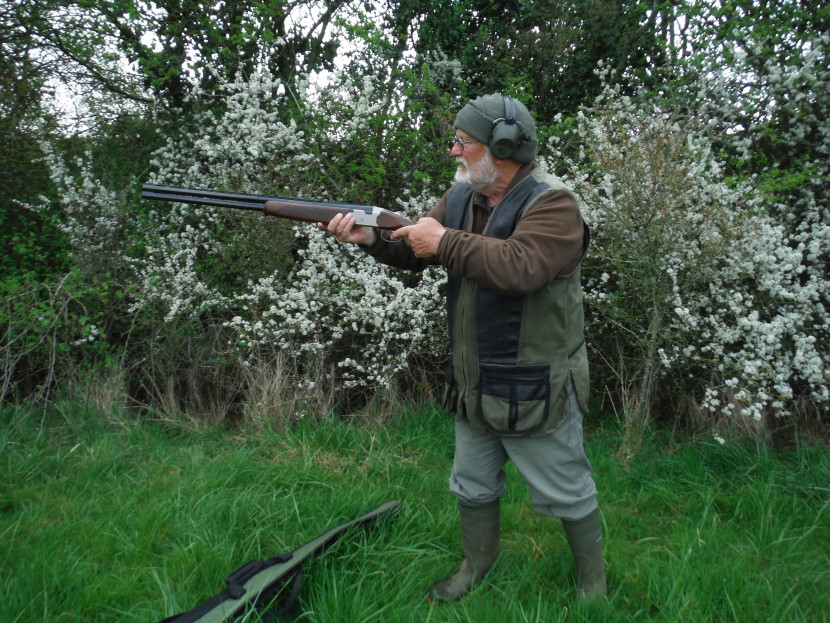 Position gun down
Position gun down 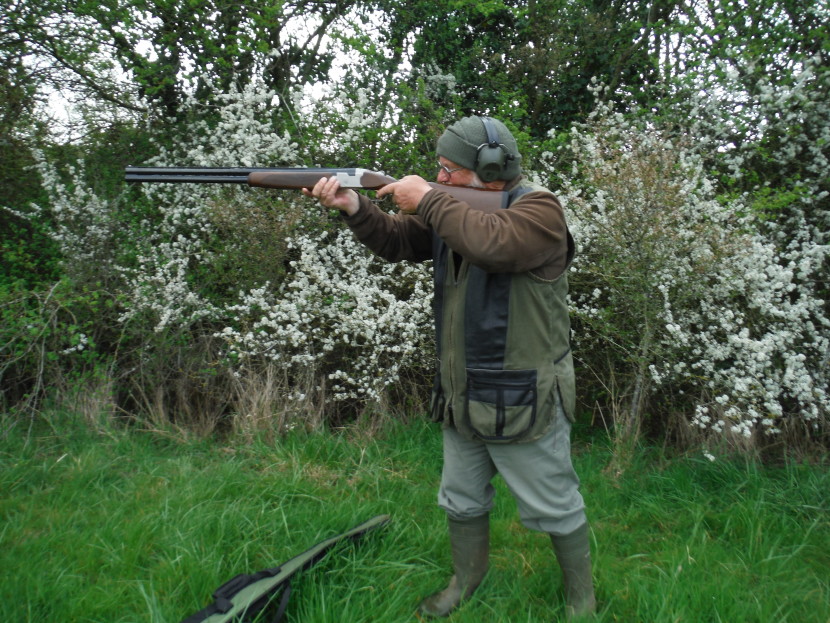 Position gun up
Position gun up To express all this in another way, while waiting gun down the shooter is able to look out for the approaching target with his/her eyes in soft focus, then on picking it up makes the mount into the cheek and shoulder and then switches to hard focus with eye or eyes lined up along the rib and fore sight before swinging with or ahead of the target and firing. It’s desirable to shoot with two eyes open, but many of us can’t.
Gun down shooting is a variant which has to be learned, but the people who believe in it tell you that it pays off in the long run. So here I am, in the process of trying to acquire the necessary muscle memory, assuming 72 year-old muscles and brain are capable of memorising anything! Here’s what I have to do. I’m left eye dominant and shoot off the left shoulder. Having closed the curtains (to avoid panic amongst the neighbours and calls to the police) I put on the same jacket and shooting vest I use at the ground, take the gun from the cabinet, check it’s empty and safe, and stand myself across the room from a facing mirror. Now taking a shooting position, gun down, I swing the gun slightly forward and into my cheek and shoulder pocket – so gun up. I don’t move my head. What I should be seeing each time the movement is made, is the reflection of my left eye in the mirror and the pip of the foresight above the muzzles. The rib has just about disappeared. Because the gun is fitted to me, there should be no contorted screwing around of my head and neck to line up the target. If I close my eyes while I make the mount, when I open them I should find exactly the same picture in the mirror. Friends tell me if I do 30 perfect mounts every day like this for a couple of months, the movement should be established. Well, let’s see.
More news from the Welsh side of the border: what we have known till now as the Brecon Beacons are to be known in future as the Bannau Brycheiniog National Park, the park authorities have decided. This name translates roughly as “The Peaks of Brychan’s Kingdom.” For those not completely au fait with Welsh history, in the 5th century Brychan was the almost legendary lord of a kingdom roughly equivalent to modern Breconshire. We are told that the new name will sit more comfortably with local Welsh people and also that “beacons” has unfortunate connotations with the burning of carbon fuels. We should know better than to be talking about fiery beacons in what is shortly to be a carbon neutral age. Right, I can follow all that. What a great opportunity to combine linguistic appropriation and virtue signalling all in one move! What do you think? Will Bannau Brycheiniog catch on in what is a mainly English-speaking part of Wales?
You will remember the case of Herefordshire’s Dayhouse Farm and the operation which was supposedly to remove a small pile of silt from the third arch of the road bridge over the Lugg there. I think I was the last angler to fish that beat and from what I saw that day the silt could have been removed in a morning by a couple of guys with shovels. Instead, 200 hours of heavy machine rental were used by the landowner to destroy over a mile of river bank.
Finally, and after what seems to have been a very long wait, welcome news arrived from Kidderminster Magistrates Court. We anglers often have criticism for the EA and Natural England, but in this particular case we should thoroughly applaud their work and the decision of the court. John Price of Dayhouse Farm, Herefordshire, received a sentence of 12 months in prison and a fine of 1.25 million pounds for the deliberate destruction of the River Lugg’s bank on his property in 2020. “Ecological vandalism,” was the judge’s comment on handing down the verdict, who was determined it should serve as an example to others.
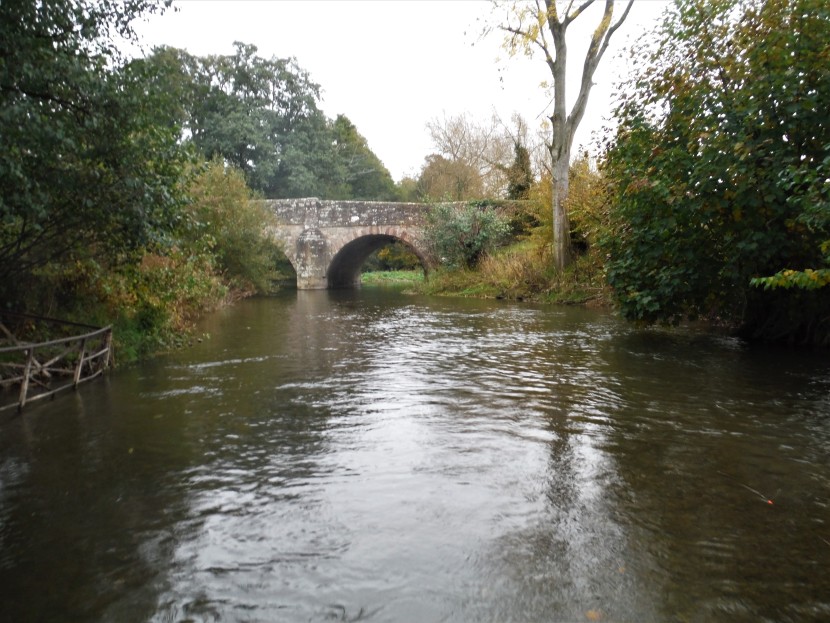 Dayhouse Bridge before the bulldozer
Dayhouse Bridge before the bulldozer 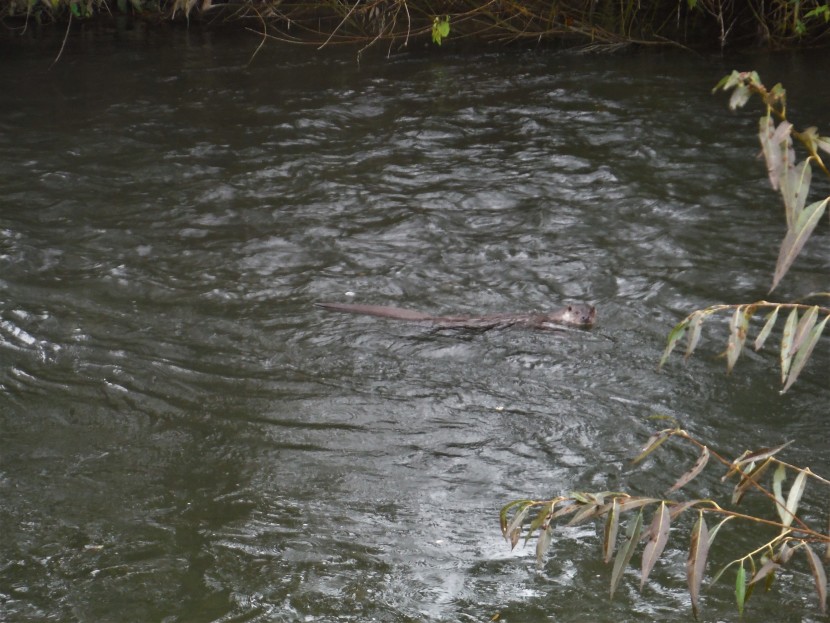 Dayhouse otter, day before the bulldozer
Dayhouse otter, day before the bulldozer It emerged that Mr Price has quite a history of failing to comply with advice or regulation from environmental agencies and even now shows little contrition, which may account for the stiff sentence. Unfortunately there seems to be a tendency in some quarters to portray Mr Price as a victim of woke and over-zealous environmental agencies when all he was trying to do was prevent flooding of his land and local houses. That at least has been the view of readers writing into the Telegraph following a very biased article on the subject. For some, Mr Price looks like becoming some kind of martyr, a role which I suspect he will enjoy. In this case, I think Mr Price’s supporters and the Telegraph have got it completely wrong; his actions had nothing to do with flood prevention and vandalism is exactly the correct word for what was done. The fine includes a theoretical 600,000 pounds cost for restoring the bank, but in practice it will be many years before the growth of new trees can restore the status quo ante. The damage will certainly remain for my life time. Mr Price’s arrogance in the face of environmental regulations may well account for the prison sentence, in addition to the fine. However, I don’t doubt there will be an appeal.
 Devastated Lugg at Dayhouse after the bulldozer
Devastated Lugg at Dayhouse after the bulldozer It’s not so often I follow the Guardian and its readership, but I think serious anglers and conservationists would do well to look at this article by Oliver Bullough, sent in to me by David Stephenson:
Read in The Guardian: https://apple.news/ADyksOIaKTICPblCFZRBGNA
My grandchildren never cease to astound me. Two of the older ones are now child actors and one of them seems to hang around all day on film sets with Lily Allen. Nice work if you can get it, I thought. But the other day my wife and I were outside the Forest looking after some of the smaller ones. Probably it’s best if I don’t reference the village and the education authority on this occasion. Suffice to say that four small boys are always a handful, especially as school time looms. “I hate going to school,” the 8 year-old said suddenly over breakfast. I have heard that one a few times before. I believe I used to have similar thoughts myself 60 and something years ago. “Well, never mind, it gets more interesting later,” I said in a somewhat unconvincing attempt at reassurance. “No it doesn’t,” the lad replied. “And if they think I’m going to marry a man, well I’m not!” This was spoken with much emphasis. After I had digested that, all I could come up with in response was: “Fair enough; good for you.” What an extraordinary modern age we live in, I thought to myself! The only consolation seemed to be that the up and coming generation just might have more sense than the one currently in charge.
Oliver Burch